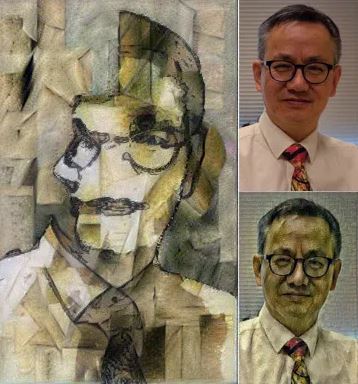Dr. Kang Zhang Develops the Art of Artificial Intelligence


It took years for Pablo Picasso to perfect his style. Now, a University of Texas at Dallas computer science professor is developing algorithms to generate unique images that mimic the cubist pioneer’s paintings in seconds.
Dr. Kang Zhang uses artificial intelligence (AI) to teach computers to create illustrations in the style of the famous masters: Jackson Pollock and his paint splatters or Joan Miró and his curved shapes and sharp lines. The process involves feeding computers examples of colors, abstract shapes and layouts so they can learn to produce their own versions of masterpieces.
Zhang, a professor of computer science and director of the Visual Computing Lab in the Erik Jonsson School of Engineering and Computer Science, uses computer science to study fine art — and he uses fine art to find ways to make better computer visuals.
He recently returned from the Czech Republic, where he spent last fall lecturing and conducting research at Charles University in Prague as a Fulbright Distinguished Chair. Zhang also traveled to Poland, Germany and Serbia to give presentations on his project, “Design and Experiment of Multi-Dimensional Information Visualization and Aesthetic Representations.”
“The computer can be a tool to develop beautiful and user-friendly designs for just about everything we see on our screens,” Zhang said. “The goal is to have art and design help computing. User interfaces, for example, are supposed to be friendly and beautiful, but they are often created by computer scientists with only function in mind.”
Zhang, who has written textbooks on the subject and lectured across the globe, is an expert in computational aesthetics, a subfield of AI that involves applying mathematical formulas to represent and analyze aesthetic features. He said the technology can help software and web developers produce better computer-generated graphics, user interfaces and visualizations of big data.
Generating visuals in the style of abstract artists involves an AI function called deep learning, which teaches the machine to process information and recognize patterns the way a human brain does and perform tasks without explicit instructions.
Zhang’s process involves splicing images, building computer models of irregular shapes, encoding the designs and writing algorithms to let the computer take over and weave the colors, layouts and shapes into new creations. For example, he and his colleagues and students have published articles in the journal The Visual Computer describing how they transformed portraits into Picasso’s cubist style and modeled Pollock’s dripping style of painting. They have also delivered conference presentations detailing a method for generating Miró’s surrealism.
In addition to generating better visuals, computational aesthetics increasingly is being used to analyze art in new ways. For example, Zhang’s study in the April 2019 edition of the journal Leonardo examined the white space in artist Wu Guanzhong’s paintings. Leaving white space by not painting over the white rice paper is typical in Chinese painting. When Zhang and the study’s co-authors collected data on viewers’ eye movements and asked viewers to rate the artwork based on various features, the researchers found that the white space in Wu’s work had a significant effect on viewers’ aesthetic experiences.
Zhang developed a passion for art while growing up in China and has won awards for his oil paintings and Chinese calligraphy. Throughout his career, he has incorporated art into his research, which, he emphasized, explores how computers can serve as tools — not replacements — for creativity.
“Computer science will not replace artists and designers,” Zhang said. “Rather, it can help both groups extend their imaginations and capability in making creative works.”
Fulbright Distinguished Chairs Program
The Fulbright Distinguished Chairs Program comprises approximately 40 distinguished lecturing, distinguished research and distinguished lecturing/research awards ranging from three to 12 months. Awards in the Fulbright Distinguished Chairs Program are viewed as among the most prestigious appointments in the Fulbright Scholar Program. Candidates should be eminent scholars and have a significant publication and teaching record.
Source | UT Dallas News Center | Kim Horner
ABOUT THE UT DALLAS COMPUTER SCIENCE DEPARTMENT
The UT Dallas Computer Science program is one of the largest Computer Science departments in the United States with over 3,315 bachelors-degree students, more than 1,110 master’s students, 165 Ph.D. students, 52 tenure-track faculty members, and 44 full-time senior lecturers, as of Fall 2019. With The University of Texas at Dallas’ unique history of starting as a graduate institution first, the CS Department is built on a legacy of valuing innovative research and providing advanced training for software engineers and computer scientists.




